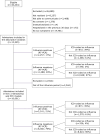Accuracy of ICD Influenza Discharge Diagnosis Codes in Hospitalized Adults From the Valencia Region, Spain, in the Pre-COVID-19 Period 2012/2013 to 2017/2018
- PMID: 39909969
- PMCID: PMC11798732
- DOI: 10.1111/irv.70069
Accuracy of ICD Influenza Discharge Diagnosis Codes in Hospitalized Adults From the Valencia Region, Spain, in the Pre-COVID-19 Period 2012/2013 to 2017/2018
Abstract
Background: International Classification of Diseases (ICD) codes obtained from real-world data can be used to identify influenza cases for epidemiological research but, without validation, may introduce biases. The objective of this study was to validate ICD influenza discharge diagnoses using real-time reverse transcription-polymerase chain reaction (RT-PCR) laboratory-confirmed influenza (LCI) results.
Methods: The study was conducted during six influenza seasons (2012/2013-2017/2018) in the Valencia Hospital Surveillance Network for the Study of Influenza (VAHNSI). Patients aged 18+ years were identified via active-surveillance and had to meet an influenza-like illness (ILI) case definition to be included. All patients were tested for influenza by real-time RT-PCR. Main and secondary influenza discharge diagnosis codes were extracted from hospital discharge letters. Positive predictive values (PPVs) and the complementary of the sensitivities (1-Sensitivity) of ICD codes with corresponding 95% credible intervals (CrIs) were estimated via binomial Bayesian regression models.
Results: A total of 13,545 patients were included, with 2257 (17%) positive for influenza. Of 2257 LCI cases, 1385 (61%) were not ICD-coded as influenza. Overall, 74.73% (95% CrI: 63.24-84.44) of LCI were not-ICD coded as influenza (1-Sensitivity) after adjustment. Sensitivity improved across seasons and with increasing age. Average PPV was 74.02% (95% CrI: 68.58-79.17), ranging from 43.71% to 81.57% between seasons.
Conclusion: Using only main and secondary discharge diagnosis codes for influenza detection markedly underestimates the full burden of influenza in hospitalized patients. Future studies, including post-COVID context, using prospective surveillance for ILI are required to assess the validity of hospital discharge data as a tool for determining influenza-related burden of disease.
Keywords: ICD codes; active surveillance; diagnosis codes; discharge diagnoses; hospitalizations; influenza; influenza‐like illness; laboratory‐confirmed influenza.
© 2025 The Author(s). Influenza and Other Respiratory Viruses published by John Wiley & Sons Ltd.
Conflict of interest statement
AMI has received fees for conferences/experts' meetings from Sanofi and for educational events from MSD. MLL has received fees for conferences meetings from Sanofi and for educational events from MSD. MLL has attended to several congresses whose registration, travel and accommodation costs have been covered by MSD, AZ and Sanofi. HB and ML are employees of Sanofi and may hold shares and/or stock options in the company. JDD has attended to several congresses whose registration, travel and accommodation costs have been covered by MSD, GSK and Sanofi. JDD and his institution received research grants from Sanofi and GSK related to RSV preventive strategies. JDD acted as advisor for these immunization strategies to Sanofi. AOS has attended to several congresses whose registration, travel and accommodation costs have been covered by MSD, GSK, Novavax and Sanofi. AOS and his institution received research grants from Sanofi and MSD related to RSV preventive strategies. AOS acted as advisor for these immunization strategies to Sanofi and Moderna. FXLL, MCF, MTG, JMM, GSC and JPB declare no conflicts of interest.
Figures
Similar articles
-
Accuracy of Influenza ICD-10 Diagnosis Codes in Identifying Influenza Illness in Children.JAMA Netw Open. 2024 Apr 1;7(4):e248255. doi: 10.1001/jamanetworkopen.2024.8255. JAMA Netw Open. 2024. PMID: 38656577 Free PMC article.
-
Validation of ICD-10 diagnostic coding for influenza in the Danish National Patient Registry.Ann Epidemiol. 2025 Feb;102:62-67. doi: 10.1016/j.annepidem.2024.12.017. Epub 2025 Jan 8. Ann Epidemiol. 2025. PMID: 39793861
-
Are we missing respiratory viral infections in infants and children? Comparison of a hospital-based quality management system with standard of care.Clin Microbiol Infect. 2019 Mar;25(3):380.e9-380.e16. doi: 10.1016/j.cmi.2018.05.023. Epub 2018 Jun 12. Clin Microbiol Infect. 2019. PMID: 29906596
-
Characteristics of influenza, SARS-CoV-2, and RSV surveillance systems that utilise ICD-coded data: a systematic review.J Glob Health. 2025 May 23;15:04177. doi: 10.7189/jogh.15.04177. J Glob Health. 2025. PMID: 40406976 Free PMC article.
-
Accuracy of routinely collected hospital administrative discharge data and death certificate ICD-10 diagnostic coding in progressive supranuclear palsy and corticobasal syndrome: a systematic review and validation study.J Neurol. 2024 Jun;271(6):2929-2937. doi: 10.1007/s00415-024-12280-w. Epub 2024 Apr 12. J Neurol. 2024. PMID: 38609666 Free PMC article.
References
-
- Iuliano A. D., Roguski K. M., Chang H. H., et al., “Estimates of Global Seasonal Influenza‐Associated Respiratory Mortality: A Modelling Study [Published Correction Appears in Lancet. 2018 Mar 31;391(10127):1262.],” Lancet 391, no. 10127 (2018): 1285–1300, 10.1016/S0140-6736(17)33293-2. - DOI - PMC - PubMed
-
- World Health Organization . “Up to 650,000 People Die of Respiratory Diseases Linked to Seasonal Flu Each Year,” (2017), accessed December 9, 2024, https://www.who.int/news/item/13‐12‐2017‐up‐to‐650‐000‐people‐die‐of‐res....
-
- Díez‐Domingo J., Torcel‐Pagnon L., Carmona A., et al., “The Value of Public‐Private Collaborative Real‐World Evidence Platforms to Monitor Vaccine Performance Post Authorization: DRIVE—A European Initiative,” Expert Review of Vaccines 21, no. 12 (2022): 1701–1710, 10.1080/14760584.2022.2137144. - DOI - PubMed
-
- Moren A., “I‐MOVE‐Plus ‐ I‐MOVE+ Integrated Monitoring of Vaccines Effects in Europe: A Platform to Measure and Compare Effectiveness and Impact of Influenza and Pneumococcal Vaccines and Vaccination Strategies in the Elderly ‐ H2020,” Impact 2018, no. 12 (2018): 82–86, 10.21820/23987073.2018.12.82. - DOI
Publication types
MeSH terms
Grants and funding
LinkOut - more resources
Full Text Sources
Medical


